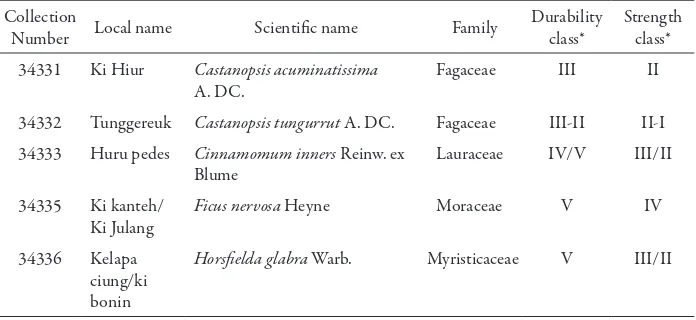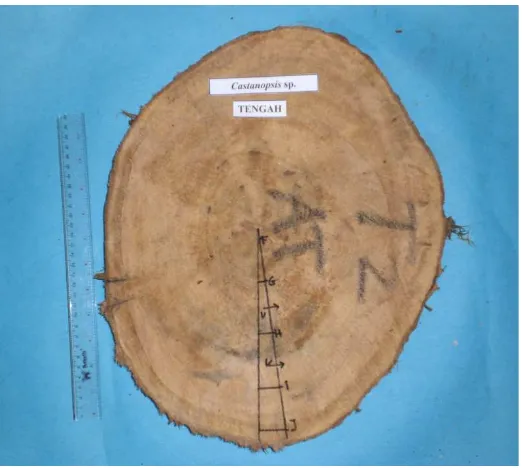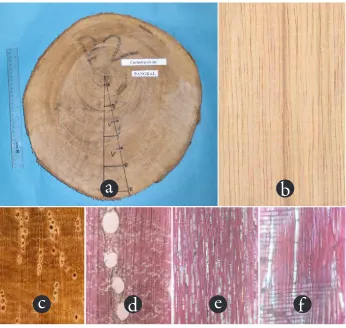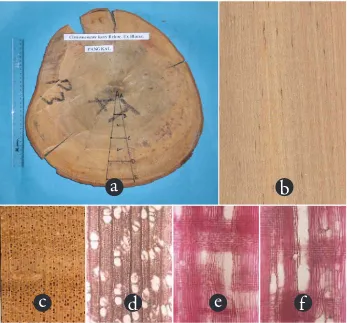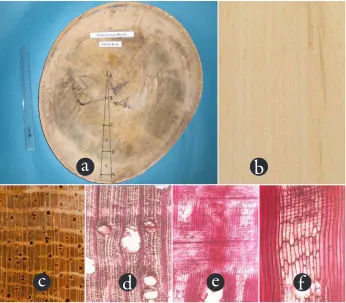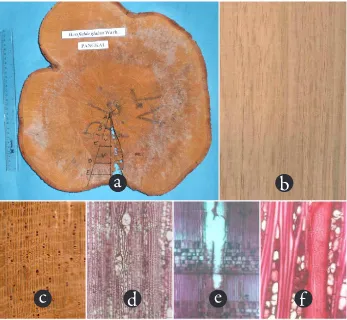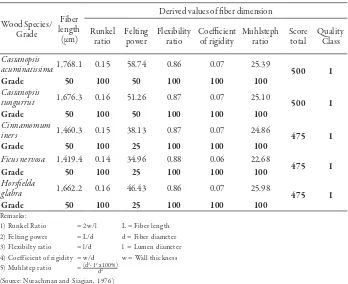CIANJUR, WEST JAVA
Ratih Damayanti1,2 and Sri Rulliaty1
ABSTRACT
A detailed description of wood anatomy is essential for assessing the use of a wood species for processing, and also beneicial for the identiication of wood samples. Computerized keys are available that allow the identiication of wood samples until the genus level; however, it is not easy to use these keys to identify unknown species. herefore, a database of anatomical characteristics and the computerized keys need to be completed up to species level. As the relevance, this study has examined the wood anatomical properties of the ive corresponding tree species originated from Cianjur, West Java, which are commercially potential for their exploitation, i.e Castanopsis acuminatissima ADC. (Fagaceae); Castanopsis tungurrut ADC. (Fagaceae); Cinnamomum inners Reinw. ex Blume (Lauraceae); Ficus nervosa Heyne (Moraceae) and Horsieldia glabra Warb. (Myristicaceae). Expectedly the results would be beneicial for wood identiication purposes and evaluation for other possible uses. Observations on anatomical structures covered macroscopic and microscopic characteristics were carried out through the sectioned and macerated wood samples. he observed characteristics of the anatomical features were deined conforming to the IAWA List of Microscopic Features for Hardwood Identiication. Based on the scrutiny on those observed characteristics and linked to the iber quality, it was judged that the iber in all the ive wood species could be classiied as class I for pulp and paper processing.
Keywords: Wood anatomy, iber quality, local potential commercial species, Cianjur (West Java)
I. INTRODUCTION
Appropriate processing of wood, especially in drying, depends upon correct species identiication, because diferent species and species groups require diferent treatments. When problems occur during wood processing (in drying, machining, or inishing), one of the irst questions arises as to whether the wood was correctly identiied or not (Wheeler and Bass, 1998). his problem can be minimized by applying wood identiication procedure at the earliest stage of wood processing. Moreover, if procedures for identifying wood material are based on an understanding of the anatomical properties of wood, it becomes possible to develop wood products that exploit these characteristics. Existing computerized key wood identiication and the databases of anatomical structures, particularly in Indonesia, have enabled them to identify up to genus level.
Speciic identiication up to species level usually can be done in commercial timber; however it must be assisted by ‘traditional’ methods. Variations in species within genus are very possible and this fact makes it diicult to recognize (Wheeler and Bass, 1998) and utilize unknown species.
here is a great potential for unknown or lesser known wood species in Indonesia to be exploited into a local commercial timber. Currently, there are about 4000 wood species available in this country (Mandang and Pandit, 2002; Pandit and Kurniawan, 2008). According to Mandang and Pandit (2002), only 400 species have been exploited for trade and have a speciic trade name. Other species commonly have been known in trading as ‘borneo’, which is a group of mix or of any kind timber. his fact shows a limited knowledge of wood as raw material for further wood processing (Krisdianto, 2005; Pandit and Kurniawan, 2008). For these reasons it is important to complete the database of anatomical characteristics and already-computerized key wood identiication to species level. his paper studied the anatomical properties of ive local potential commercialized woods obtained from trees grown in Cianjur, West Java. he study will be important for species identiication and assessment for possible utilization of those timbers for pulp, paper, and other processed products.
II. MATERIALS AND METHODS
Five local wood species regarded as potentially commercial were collected from Sukanegara Selatan, Cianjur, West Java. For scientific botanical authenticity, the herbarium specimens were identiied in Herbarium Bogoriense. Proiles of these ive timber species in accordance with local name, scientiic name, collection number in Xylarium Bogoriense 1915, and durability class as well as strength class based on Oey (1964) are elaborated in Table 1.
Table 1. Description of collection number, name, durability class, and strength class of ive local potential woods from Cianjur, West Java
Collection
Number Local name Scientiic name Family
Durability class*
Strength class* 34331 Ki Hiur Castanopsis acuminatissima
A. DC.
Fagaceae III II
34332 Tunggereuk Castanopsis tungurrut A. DC. Fagaceae III-II II-I 34333 Huru pedes Cinnamomum inners Reinw. ex
Blume
Lauraceae IV/V III/II
34335 Ki kanteh/ Ki Julang
Ficus nervosa Heyne Moraceae V IV
34336 Kelapa ciung/ki bonin
Horsielda glabra Warb. Myristicaceae V III/II
Wood samples in the disc form of 10 cm in thickness were taken from three particular tree heights, i.e. bottom, middle and top portions of the corresponding logs. At each height, samples for iber maceration were prepared from ive parts moving inward radially between the pith and the bark. he location of sectioning the wood sample in heartwood area for microtome slide is marked by V sign, as shown in Figure 1.
Figure 1. Cross-sectional view of the sample-cutting pattern for macerated and sectioned sample. F-J lines are the points for macerated samples, while V mark reveals the location in heartwood for sectioned samples.
Observation on anatomical structures covered macroscopic (general) and microscopic characters. Macroscopic features as observed on the inished surface of the sample were suggested by Mandang and Pandit (2002) that cover color, igure, texture, slope of grain, hardness, luster, odor and surface impression.
Microscopic characteristics were examined in the sectioned samples. hree block sections prepared from heartwood were assigned for examination of anatomical features and properties on consecutively cross-sectional (transverse), radial, and tangential surfaces of the block. he block sections for such anatomical feature examination were irst air-dried and then soaked in distilled water for about 1 week. Ater being saturated, the samples were then transferred into a container containing a sotening solution of
concentrations consecutively of 30, 50, 70, and 96%, and ultimately absolute ethanol. he slices were cleaned to drive away the alcohol by soaking them in carboxylol and
toluene. he last step in sample preparation was to mount the slices on the object glass using entellan (Damayanti et al., 2007).
he characteristics as observed with respect to the anatomical features were based on the IAWA Committee List of Microscopic Features for Hardwood Identiication (Wheeler et al., 1989). Some features represented quantitative data. he quantitative data in this study signiied the irst measurement to be performed on certain features like tangential diameter of vessels (25-times measurements), frequency of vessels per mm square, frequency of rays per mm (10-times over ten diferent areas), and heights of rays (25 times), and then calculating the average (Krisdianto and Damayanti, 2007). he quantitative data of iber dimension (diameter and thickness of cell walls were measured 15-times, respectively) and vessel length (25-times measurements) were measured from the macerated samples. In this regard, the wood samples were macerated according to the method of Tesoro (1989). he sample materials were heated slowly at 40 - 60 ºC in the mixture of concentrated nitric acid and hydrogen peroxide (H2O2) at a ratio of 1:1. he heating process took about 12 hours to produce adequately macerated material or a satisfactory separation of cells for further dimensional measurement.
he separated iber cells were washed by water to rid the cells completely free of residual acid and H2O2, and then the cells were dyed by saranin. To examine their dimensions, the cells were placed on the object glass; ethanol-glycerin was then added, and the cells were evenly spread on the glass using a coarse needle before closing the object glass with cover glass. he qualiication of iber for pulp and paper was based on the criteria of Nurachman and Siagian (1976), through the determination of iber dimension and its derived values.
III. RESULTS AND DISCUSSION
A. Anatomical Properties
1. Castanopsis acuminatissima A.DC. (Ki Hiur)
General characteristics: Heartwood is generally brownish-yellow, rather easily demarcated from pale yellow sapwood. Figure is plain up to alternate lines in brown color. Texture is coarse and uneven. Grain is straight to interlocked. he wood is hard and no special odor. he longitudinal surface is slippery and lustrous.
to three cells wide, and or scalariform axial parenchyma; 5-8 cells per parenchyma strand. Rays: homocelluler, all ray cells procumbent. his species has two distinct sizes of rays. he narrow rays are exclusively uniseriate, 8 rays per milimeter; the larger rays are commonly more than 10 seriate. Fiber: 1,750 µm long; non septate; thin to thick-walled; with simple to minutely bordered pits. Mineral inclusions: prismatic crystal present in radial alligment in procumbent ray cells and chambered axial parenchyma cells. Anatomical structure of Castanopsis acuminatissima is presented in Figure 2.
2. Castanopsis tungurrut A.DC. (Tunggereuk) - Fagaceae
General characteristics: Heartwood is pale brownish-yellow, indistinctly demarcated from yellowish sapwood. Figure is plain. Texture is ine and moderately even. Grain is straight to moderately interlocked. Wood is hard, slippery and not lustrous. No special odor.
Figure 3. Castanopsis tunggurut - Fagaceae. (a) cross sectional surface of the stem, (b) longitudinal surface, x 1 (c) transverse surface (macroscopic), x 10 (d) transverse surface (microscopic), x 40 (e) tangential surface, uniseriate rays, x 40 (f ) prismatic chrystal in chambered axial parenchyma, x 100.
3. Cinnamomum inners Reinw. ex Blume (Huru Pedes) - Lauraceae
General characteristics: Heartwood is yellowish light brown, distinctly demarcated from sapwood. Figure is plain; ine and even texture; and straight to interlocked grain. Wood is hard and has special camphor-like odor. he longitudinal surface is slippery and not lustrous.
simple, pits are rounded or angular, horizontal (scalariform, gash-like) to vertical (palisade). Tyloses are commonly present in vessels. Axial parenchyma: apotracheal difuse, paratracheal vasicentric and aliform; 3-8 cells per parenchyma strand. Rays: multiseriate, 1-3 cells width. Cellular compositions is the procumbent body ray cells with one row to 2-4 rows of upright and/or square marginal cells. Frequency 5 rays per mm. Fiber: 1450 µm long; non septate; thin-to thick-walled; with simple to minutely bordered pits. Mineral inclusions: absent. Secretory element: oil cells assosciated with ray and axial parenchyma. Anatomical structure of Cinnamomum inners is presented in Figure 4.
4. Ficus nervosa Heyne (Ki Kanteh/Ki Julang) - Moraceae
General characteristics: Heartwood is yellowish white, not clearly diferentiated from the sapwood. Figure is plain, sometimes there are darker colored streaks produced by parenchyma, giving rise to watered-silk igure on tangential surface, and palisade efects on radial surface. Texture is coarse and uneven due to the abundant of parenchyma. Grain is straight to deeply interlocked. Wood is sot, lusterless and rough. No special odor.
Figure 5. Ficus nervosa - Moraceae (a) cross sectional surface of the stem (b) Longitudinal surface, x 1 (c) transverse surface (macroscopic), x 10 (d) transverse surface (microscopic), x 40 (e) radial surface, x 40 (f ) axial parenchyma storied, x 100.
5. Horsielda glabra Warb. (Kelapa ciung/ki bonin) - Myristicaceae
General characteristics: Heartwood is reddish light brown, diicult demarcated from the pale brownish yellow sapwood. Figure is plain. Texture is ine and even. Grain is straight to interlocked, sometimes slighty wavy. Wood is moderately hard, rather rough, and lusterless. No special odor.
in the same ray cells. Tyloses common are present in vessels. Axial parenchyma: scanty paratracheal to vasicentric; banded parenchyma in narrow bands or lines up to three cells wide; axial parenchyma in marginal or in seemingly marginal bands; 5-8 cells per parenchyma strand. Rays: multiseriate, 1-10 seriate cells width. Cellular compositions is the procumbent body ray cells with one row to 2-4 rows of upright and/or square marginal cells; and rays with procumbent, square and upright cells mixed throughout the ray. Frequency 7 rays per mm. Fiber: 1400 µm long, non septate; thin-to thick-walled; with simple to minutely bordered pits. Mineral inclusions: druses present in chambered cells. Anatomical structure of Horsieldia glabra is presented in Figure 6.
Microscopically, woods from the families Fagaceae (Castanopsis sp.), Moraceae (Ficus sp.) and Myristicaceae (Horsieldia sp.) have indistinct growth rings, in contrast to the Lauraceae family (Cinnamomum sp.) which has distinct growth rings because of its thick-walled and lattened latewood ibers.
Belonging to the same genus and family, Castanopsis acuminatissima (Ki Hiur)and
C. tungurrut (Tunggereuk) have the same porosity, vessel arrangement, ibers and axial parenchyma structures. However, Ki Hiur tends to have an axial parenchyma scalariform pattern. Further, the structure in rays is very diferent. While both species have uniseriate ray width, exclusively uniseriate in C. tungurrut, but C. acuminatissima also has very wide multiseriate rays (more than 10 seriate) that give this species two distinct sizes of rays. Another diference is that mineral inclusion in C. acuminatissima is more abundant than that in C. tungurrut. In C. tungurrut, crystal can be observed both in procumbent ray cells and chambered axial parenchyma cells, whereas in C. acuminatissima, crystal can only be observed in chambered axial parenchyma.
Aside from the presence of distinct growth ring boundaries, features of the Lauraceae family (C. inners), that difer from other families include the presence of scalarifom perforation plates in the vessel and the existence of oil/mucilage cells associated with ray and axial parenchyma. hese cells function to exude the aromatic fragrance that makes this species special.
Ficus nervosa (Moraceae family) has speciic characteristics that include regular axial parenchyma bands more than three cells wide and very complex vessel-ray pitting. hree features can be observed comprising vessel ray-pits with distinct borders similar to intervessel pits in size and shape throughout the ray cells; vessel-ray pits with much reduced borders to apparently simple, pits rounded or angular; and vessel-ray pits unilaterally compound and coarse.
he speciic characteristics of Horsieldia glabra are the opposite and alternate intervessel pits present in the vessel cell. Vessel-ray pitting is multivarious and four features can be observed being vessel ray-pits with distinct borders-similar to intervessel pits in size and shape throughout the ray cells; vessel-ray pits with much reduced borders to apparently simple; pits horizontal (scalariform, gash-like) to vertical (palisade); and vessel-ray pits of two distinct sizes or types in the same ray cells. his species has many variaties of heterocellular rays with the procumbent body of ray cells boundaried with one row; 2-4 rows, and over 4 rows of upright and/or square marginal cells; and rays with procumbent, square and upright cells mixed throughout the ray.
For wood identiication purposes, the diagnostic characteristics from these timbers are:
1. Castanopsis acuminatissima: heartwood brownish yellow, sapwood pale yellow. Figure
(uniseriate) and wide (multiseriate). Prismatic crystals present in radial alignment in procumbent ray cells and in chambered axial parenchyma cells.
2. Castanopsis tungurrut: heartwood pale yellow, brownish, hardly demarcated from
yellowish sapwood. Vessels exclusively solitary and in diagonal or radial pattern. Vascular/vasicentric tracheids present. Only one size of rays (uniseriate), homocelular, just comprising of procumbent cells. Prismatic crystals present in chambered axial parenchyma cells.
he diferences between C. acuminatissima and C. tungurrut are the two distinct sizes of rays in C. acuminatissima; the homocelular composition that is procumbent in C. tungurrut; and the prismatic crystal present in both radial alignment in procumbent ray cells and in chambered axial parenchyma cells in C. tungurrut which can only be observed in chambered axial parenchyma cells in C. acuminatissima.
3. Cinnamomum inners: heartwood pale brown, yellowish, clearly diferentiated from
the sapwood. he wood has a persistent camphor-like odor. Growth ring boundaries distinct. Perforation plate simple and scalariform. Oil cells associated with ray and axial parenchyma.
4. Ficus nervosa: the color of wood is yellowish white. hree characteristics of vessel
ray pits (vessel-ray pits with distinct borders, similar to intervessel pits in size and shape throughout the ray cells; with much reduced borders to apparently simple, pits rounded or angular; and vessel-ray pits unilaterally compound and coarse). Axial parenchyma bands more than three cells wide in regular pattern. Axial parenchyma and ibers storied.
5. Horsieldia glabra: heartwood pale brown, reddish, not clearly demarcated from
the pale brownish yellow sapwood. Intervessel pits opposite and alternate. Four characteristics of vessel ray pits (vessel-ray pits with distinct borders, similar to intervessel pits in size and shape throughout the ray cells; with much reduced borders to apparently simple, pits rounded or angular, and pits horizontal (scalariform, gash-like) to vertical (palisade); and vessel-ray pits of two distinc sizes or types in the same ray cells). Mineral inclusions, druse, present in chambered cells.
B. Fiber Quality
Table 2. Average value of iber wood dimension Castanopsis acuminatissima 1,768.1 ±150.5 30.1 ±4.2 26.0 ±4.1 2,0±0,4 Castanopsis tungurrut 1,676.3 ±133.0 32.7 ±3.1 28.3 ±3.1 2,2±0,4 Cinnamomum inners 1,460.3 ±221.6 38.3 ±3.3 33.2 ±3.2 2,5±0,4 Ficus nervosa 1,419.4 ±140.5 40.6 ±4.7 35.7 ±4.6 2,5±0,5 Horsielda glabra 1,662.2 ±154.0 35.8 ±4.1 30.9 ±3.7 2,4±0,5 *) Average of 375 ibers measurement
Calculation of iber dimension derived value and determination of class quality for pulp and paper were based on the procedure and criteria of Nurachman and Siagian (1976) presented in Table 3.
Table 3. Fiber dimension derived value and iber class quality for pulp and paper
Wood Species/
ratio Felting power Flexibility ratio Coeicient of rigidity Muhlsteph ratio Score total Quality Class
Castanopsis
acuminatissima1,768.1 0.15 58.74 0.86 0.07 25.39 500 I
Grade 50 100 50 100 100 100
Castanopsis
tungurrut 1,676.3 0.16 51.26 0.87 0.07 25.10 500 I
Grade 50 100 50 100 100 100
Cinnamomum
iners 1,460.3 0.15 38.13 0.87 0.07 24.86 475 I
Grade 50 100 25 100 100 100
Ficus nervosa 1,419.4 0.14 34.96 0.88 0.06 22.68
475 I
Grade 50 100 25 100 100 100
Horsielda
glabra 1,662.2 0.16 46.43 0.86 0.07 25.98 475 I
Grade 50 100 25 100 100 100
Based on the calculation results in Table 4, the iber quality of the ive wood species as proposed materials for pulp and paper can be judged as class I. According to Nurachman and Siagian (1976), the wood characteristics of class I iber quality cover moderate to low density wood species (strength class IV/V) with extremely thin wall and wide lumen. Fibers collapse completely during pulp sheet forming; lattenning and felting characteristics are high, resulting in high tear, burst and tensile strength of the corresponding pulp.
Usually, wood species with iber quality of class I belong to strength class IV/V. Based on Oey (1964), the strength classes of Castanopsis spp. fall into II-I, while those of Cinnamomum inners and Horsieldia glabra are III-II, which does not match that as proposed by Nurachman and Siagian (1976). he possible explanation is that there are considerable decreases in density and strength class for the woods that have been examined by Oey (1964) compared to the woods of the similar kinds this time. As this was still a preliminary study, further investigation is required to clarify this uncertainty. Moreover, to obtain more reliable results to support basic classiication in determining the quality of pulp and paper processing, future research should also examine the chemical components of the wood such as cellulose, lignin, pentosan, extractive and ash contents.
C. Evaluation of Possible Uses
According to Lemmens et al. (1995), Castanopsisis suitable for medium to heavy construction under cover like for house posts, lining, bridges, furniture, looring, plywood, sliced veneer, packing cases, pallets, fence posts, mine props, shingles, shakes, boat building and irewood. Cinnamomum inners is suitable for decorative work such as interior inish and paneling, for furniture, cabinet making, lining chests, and wardrobes; and is suitable for plywood manufacture.
For Ficus and Horsieldia, according to Sosef et al. (1998), Ficus is appropriate for temporary construction, mouldings, interior work, cladding, drawers, concrete formwork, dugouts, laundry tubs, small domestics article, fruit crates, floats and irewood. From the same reference, Horsieldiausually can be used for light or temporary construction, looring, boat building, interior trim, joinery, wall paneling, shelving, lining, mouldings, sporting goods, packing cases, crates, matchboxes and match splints, and for production of particle board and plywood.
Of the five wood species examined, according to the traditional wood uses,
especially in planning and sawing. However, the regular bands of parenchyma in Ficus nervosa and Horsieldia glabra make them possible for use as pencil materials.
IV. CONCLUSION
This study has scrutinized deeply the anatomical properties and diagnostic characteristics of ive wood species originated (indigenous) from Cianjur (West Java), i.e. Castanopsis acuminatissima A.DC. (Fagaceae), Castanopsis tungurrut A.DC. (Fagaceae);,Cinnamomum iners Reinw. ex Blume (Lauraceae); Ficus nervosa Heyne (Moraceae) and Horsieldia glabra Warb. (Myristicaceae), which are all commercially potential to be exploited.
Further, the acquired data and information regarding those anatomical properties and diagnostic feature can be expectedly beneicial to complete Xylarium Bogoriense 1915 key of wood identiication. Judging from the preliminary study on iber quality, all ive wood species could be categorized as class I for pulp and paper processing. However, those ive wood species have its own speciic charactereristics that deserve thorough consideration for particular processing not only for pulp and paper but also for other wood products.
ACKNOWLEDGEMENTS
he authors would like to deeply appreciate Mr. Usep Sudardji and Ms. Tutiana for their meliculous helps in preparing the sectional and macerated slides, and in measuring the dimensions of wood ibers.
REFERENCES
Damayanti, R., Y.I. Mandang, and T.K. Waluyo. 2007. Struktur anatomi dan kualitas serat batang kemenyan (Styrax spp.) dari Sumatera Utara. Jurnal Penelitian Hasil Hutan 25 (3): 272-289 (in Indonesian with English abstract).
Krisdianto. 2005. Anatomi dan kualitas serat tujuh jenis kayu kurang dikenal dari Jawa Barat. Jurnal Penelitian Hasil Hutan 23 (4): 259-282 (in Indonesian with English abstract).
Krisdianto and R. Damayanti. 2007. Anatomical properties and iber dimension of prickly acacia (Acacia nilotica L.) from Baluran National Park. Journal of Forestry Research 4 (2): 93-103.
Mandang, Y.I. and I.K.N. Pandit. 2002. Pedoman Identiikasi Jenis Kayu di Lapangan. Yayasan Prosea, Bogor dan Pusat Diklat Pegawai SDM Kehutanan, Bogor. 194p. Nurachman, A.N. and R.M. Siagian. 1976. Dimensi Serat Jenis Kayu Indonesia. Laporan
No.75. Lembaga Penelitian Hasil Hutan, Bogor. 11p.
Oey, D.S. 1964. Berat Jenis Kayu Indonesia dan Pengertian Berat Jenisnya untuk Keperluan Praktek. Pengumuman No.13, Lembaga Penelitian Hasil Hutan, Bogor. 234p.
Pandit, I.K.N. and D. Kurniawan. 2008. Sifat Kayu sebagai Bahan Baku dan Ciri Diagnostik Kayu Perdagangan Indonesia. Centium, Bogor. 114p.
Sosef, M.S.M., L.T. Hong and S. Prawirohatmodjo. 1998. Plant Resources of South East Asia 5 (3), Timber trees: Minor Commercial Timbers. PROSEA Foundation Indonesia, Bogor. 859p.
Tesoro, F.O. 1989. Methodology for Project 8 on Corypha and Livistona. Forest Products Research and Development Institute, College, Laguna 4031. Philippines. Wheeler, E.A. and P. Baas. 1988. Wood identiication: A review. IAWA Journal 19 (3):
241-264.
